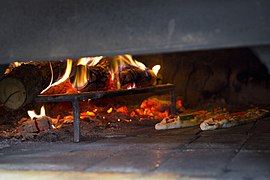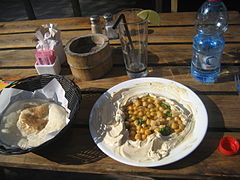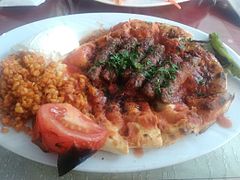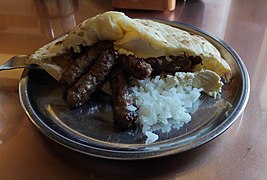Pita
 Pita from Greece | |
| Alternative names | Pide, Khubz |
|---|---|
| Type | Flatbread |
| Region or state | Eastern Mediterranean, Middle East [1] |
| Main ingredients | Wheat flour, water, yeast, salt |
Pita (
Etymology
The first mention of the word in English cited in the
The word has been borrowed by the
In Arabic, the phrase خبز البيتا (khabaz albayta, lit. "pita bread") is sometimes used; other names are simply خبز (khubz, "bread"), الخبز العربي (al-khubz al-ʿarabiyy, "Arab bread") or خبز الكماج (khabaz al-kimaj, "al-kimaj bread").[18] In Egypt, it is called عيش بلدي (ʽēš baladi) or simply عيش (ʽēš, "bread"),[19] although other subtypes of "bread" are common in Egypt, such as eish fino and eish merahrah.
In Greek, pita (πίτα) is understood by default to refer to the thicker, pocketless Greek pita, whereas the thinner khubz-style pita is referred to as aravikí pita (αραβική πίτα, lit. "Arabic pastry").
History
Pita has roots in the prehistoric flatbreads of the Near East.
Preparation

Most pita breads are baked at high temperatures (450–475 °F (232–246 °C)), which turns the water in the dough into steam, thus causing the pita to puff up and form a pocket.[25] When removed from the oven, the layers of baked dough remain separated inside the deflated pita, which allows the bread to be opened to form a pocket. However, pita is sometimes baked without pockets and is called "pocket-less pita". Regardless of whether it is made at home or in a commercial bakery, pita is proofed for a very short time—only 15 minutes.[26]
Modern commercial pita bread is prepared on advanced automatic production lines, processing 100,000-pound (45,000 kg) silos of flour at a time and producing thousands of pitas per hour. The ovens used in commercial baking are much hotter than traditional clay ovens—800–900 °F (427–482 °C)—so each pita is baked only for one minute. The pita are then air-cooled for about 20 minutes on conveyor belts before being shipped immediately or else stored in commercial
Culinary use
This article needs additional citations for verification. (December 2018) |
Pita can be used to scoop sauces or dips, such as
In
In
In
In
Pita is also present in the cuisine of the Aromanians.[35]
-
Pide baking in wood fired oven in Istanbul
-
Karadeniz pidesi from Turkey topped withkaşarcheese
-
Ramadan pide
-
Gyro pide wrap
-
Baked khubz on conveyor in Tell Rifaat, Syria
-
pilav
-
Bosnian ćevapi served with local pitta variety called "somun"
See also
![]() The dictionary definition of pita at Wiktionary
The dictionary definition of pita at Wiktionary
- Chapati – an unleavened flatbread from the Indian subcontinent
- Flour tortilla – a thin unleavened flatbread from Mexico
- Focaccia – a flat oven-baked bread from Italy
- Injera – a sourdough-risen flatbread from East Africa
- Khachapuri – a breaded cheese dish from Georgia
- Markook – an unleavened flatbread from the Middle East
- Ramadan pita)
- Naan – a leavened, oven-baked flatbread from Central and South Asia
- Pită de Pecica – a round bread from Romania
- Rghaif – a pancake-like bread from Northwest Africa
References
- ^ ISBN 9780544186316.
- ^ "Pita". Cambridge English Pronouncing Dictionary (18th ed.). Cambridge University Press. 2011.
- ISBN 9780970971685– via Google Books.
The best-known bread of the region is khubz arabi (or, simply, khubz), a round, flat, slightly leavened loaf about one-fourth inch thick and with a pocket inside. It is made in three different sizes: large (eight or more inches in diameter), medium (six to eight inches), and small (about five inches). In America, where it has become very popular, this bread is known as pita. A pocketless version is also available. In some Arab communities khubz arabi is called kmaj (from the Persian kumaj), while in others, kmaj refers only to the pocketless type.
- ISBN 9780160380440.
Pita bread originated in the Middle East and is also known as Arabic, Syrian, and pocket bread.
- ISBN 9780191040726– via Google Books.
- ISBN 9781558322271.
- ISBN 9780307558565– via Google Books.
- ISBN 9781439855652.
- ^ a b c "pitta". Oxford English Dictionary (Online ed.). Oxford University Press. (Subscription or participating institution membership required.)
- ^ Aristotle University of Thessaloniki, Λεξικό της κοινής Νεοελληνικής
- ^ Liddell, Henry George; Scott, Robert; Jones, Henry Stuart. A Greek–English Lexicon.
- ^ Javna, John. Uncle John's FACTASTIC Bathroom Reader, Printers Row, 2015
- ISBN 960-86190-1-7.
- OED s.v. 'picture' nor by Buck, Carl Darling, A Dictionary of Selected Synonyms in the Principal Indo-European Languages (1949). 9.85 "paint", p. 629
- ^ Bracvini, G. Princi (1979). Archivio Glottologico Italiano. Vol. 64. pp. 42–89. Cited by the OED.
- ^ Kramer, J. (1990). Balkan-Archiv. Vol. 14–15. pp. 220–231. Cited by the OED.
- ISBN 978-0471741725.
- ISBN 978-3-319-14687-4.
- ISBN 978-1-134-66525-9.
- ^ "World's oldest bread found at prehistoric site in Jordan", The Jerusalem Post, 2018, retrieved 16 July 2018
- ^ "Archaeologists find world's oldest bread and new evidence of sophisticated cooking dating back 14,000 years". The Independent. Retrieved 17 July 2018.
- ISSN 0362-4331. Retrieved 16 March 2019.
- ISBN 9780226067353– via Google Books.
- ISBN 9780190265434– via Google Books.
- ^ a b McNulty, Mary (2007). "Pita Bread". How products are made. Retrieved 8 May 2018.
- ^ Tanis, David (21 February 2014). "Homemade Pita Bread". The New York Times. Retrieved 8 May 2018.
- ^ Colon-Singh, Rose (12 June 2012). "Make Flatbread | Turkish Pide Recipe". Fine Dining Lovers. Retrieved 10 December 2018.
- ^ "Dayi'nin Yeri Turkish Restaurant, Cliffside Park, NJ". www.chowgofer.com. Retrieved 10 December 2018.
- ^ Elise, Lola (16 December 2009). "Pide Recipe". Tasty & Healthy Arbuz. Retrieved 10 December 2018.
- ^ Babs, Serena (17 January 2011). "Turkish Pizza aka Kiymali Pide". Tasty Kitchen. Retrieved 10 December 2018.
- ^ Ιφιγενεια Βιρβιδακη, Νενα Δημητριου, Νικολετα Μακρυωνιτου, Καλλιοπη Πατερα, "Tα καλύτερα ψωμιά των Αθηνών", Γαστρονόμος, Η Καθημερινή, 21 September 2016
- ^ Ιφιγενεια Βιρβιδακη, Νενα Δημητριου, Νικολετα Μακρυωνιτου, Καλλιοπη Πατερα, "Tα καλύτερα ψωμιά των Αθηνών", Γαστρονόμος, Η Καθημερινή, 21 September 2016 [1]
- ^ "A Taste of Druze Cuisine". Tabletmag. 20 November 2019.
- ISBN 9781787019249.
- ^ Bara, Mariana (2014). "Constructing Armân/Vlach Ethnic Identity" (PDF). HyperCultura. 3 (1): 1–11.












